SANTANA, Marcio Roberto [1]
SANTANA, Marcio Roberto. The reverse logistics and your Importance to Organizational and environmental sustainability. Multidisciplinary Core scientific journal of knowledge. 03 year, Ed. 06, vol. 04, pp. 36-51, June 2018. ISSN:2448-0959
Summary
This article covers the subject of logistics on a point which only now begins to have a look at caring for enterprises. While the logistics worries about the output flow of products, reverse logistics or Supply Chain Management reverse cares about the return of the products, materials and parts to the production process of the company. Environmental awareness promoted by severe environmental legislations and the awareness of consumers, is forcing companies to use more recyclable materials and also taking these to worry about disposal environmentally friendly of their products at the end of their life cycles, aiming at the sustainability of our planet. This work took place from the discussion of existing theories in secondary sources for understanding, as: books, scientific articles, dissertations and theses that deal with the subject of reverse logistics applied on companies, and your impact on the environment from its processes. Through the qualitative research sought to clarify the positive aspects of the implementation of the reverse logistics, so that it becomes an important factor for the sustainability of both companies with the environment too. We analyzed the cases described in the literature, aiming to highlight the concept of reverse logistics for materials recycling activities and your importance to environmental sustainability, explaining the reasons for the use of the reverse logistics Reverse logistics costs and environmental concerns.
Keywords: reverse logistics, recycling, sustainability, environment.
1. Introduction
Since ancient times man has always sought to maintain a relationship of domination over nature. And, along the timeline, from your creativity, this same man, aiming to ensure your existence in a hostile environment, developed mechanisms from their discoveries that led to the various forms of domination over all other living beings. What triggered these days, as a result of environmental degradation. The Industrial Revolution accelerated this process, through the technological advancement produced from your home, increasing competition among all industrial sectors to meet the consumer markets, strengthening over the days that followed the acceleration in the rotating time on production, which increased considerably bringing consumption as a side effect the idea of a world instant and disposable, what has been revealing how a fact perverse for the environment and all its inhabitants, putting in check the sustainability of our planet. This is because the majority of industries considered the environment only as a location, a priori, for the acquisition of raw material and, a posteriori, for your disposal of the products consumed.
According to Fuller et. Al (1995) mankind has advanced range of 20% more natural resources than the planet is able to reset, with that is advancing in Earth's natural stocks, being that there are resources that are not renewable resources such as oil.
Currently, consumption has generated large amounts of garbage, the famous organic waste, chemicals, and the mismanagement of these, and is causing exorbitant spending, causes serious damage to the environment and their populations.
Is from the listed above, this study seeks to show how the reverse logistics reveals itself as a theme of the utmost importance to organizational and environmental sustainability, reverberating as well in the entire population of the planet. Because the reverse logistics covers the reverse channels and after-sales post-consumer, favoring the balance between the quantities discarded and reused, leading also to place the waste that cannot be reused more bringing as Let's see, sustainability for organisations end up strengthening its brands from an active attitude towards the environment, thus creating new opportunities for lucrative deals with reverse logistics, and also for the environment that becomes less explored, with regard to natural resources and also less beaten, with regard to the number of drops in a smaller scale of waste in your midst. Without mentioning the present and future generations that increase your quality of life from the environmental preservation.
Through the qualitative research sought to clarify the positive aspects of the implementation of the reverse logistics, so that it becomes an important factor for the sustainability of both companies with the environment too. We analyzed the cases described in the literature, aiming to highlight the concept of reverse logistics for materials recycling activities and your importance to environmental sustainability, explaining the reasons for the use of the reverse logistics Reverse logistics costs and environmental concerns.
2. Reverse logistics
Until recently the logistics restricted only to delivery of the product to the client, and after that, manufacturers were carrying any responsibility for the products marketed. In this way there was no responsibility of the manufacturer's collection in relation to reverse distribution channels after sales and post-consumer. However, this horizon began to change from the approach of the term reverse logistics.
To situate the reader it is interesting to note that the term reverse logistics has evolved over time from the approach given by each author that has been perched on the theme. In the evolution of the term reverse logistics we have, for example, C.L. M (1993) the reverse logistics is related to agilidades and work involved in minimizing management, handling and allocation of waste products and packaging. Already in Stock (1998) is the setting of the reverse logistics, seen through the perspective of a business logistics, refers to the role of logistics in return of products, source reduction, recycling, materials substitution, material reuse, waste disposal, reform, repair and remanufacturing. In Rogers and Tibben-Lembke (1999) the reverse logistics is thus defined: as a process of planning, implementing and controlling the efficient, effective flow cost of raw materials, inventory, finished goods and related information, from the point of origin to the point of consumption, for the purpose of recapturing value or tailor your destiny. On the subject of logistics, Dornier et al (2000) brings something new, since it encompasses new areas of logistics, adding that also the reverse-flow management. Bowersox and Closs (2001) brings the idea of monitoring the life cycle, i.e. from birth (production) of the commodity, until your appropriate disposal.
The figure below helps us get a better understanding of the area and reverse steps that include reverse logistics, although there are other areas addressed by theme:
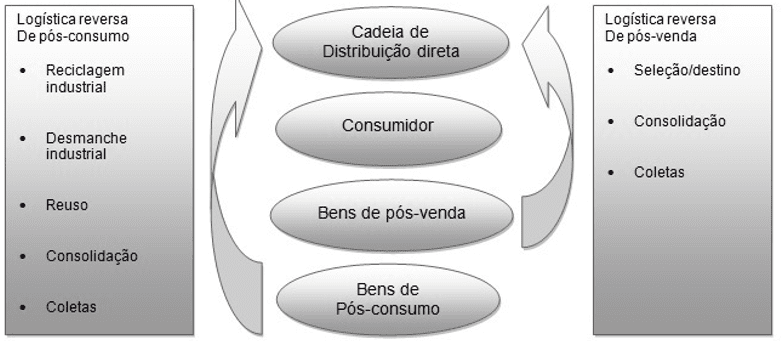
Second (2002), the strategic objective of the reverse logistics aftermarket is to add value to a product that was returned logistics for commercial reasons, order processing failures, guarantee given by the manufacturer, malfunction of the products, problems caused due to transport your products, among other reasons.
According to milk (2002), the strategic objective of the reverse logistics of post-consumer relates to the ensemble of logistic product value that no longer serves more for the consumer, or that still have some use for discarded products, for reached the end of your life and for industrial waste. These consumer goods may originate from durable goods or disposable, passing by several reverse channels of reuse, dismantling, recycling until the final destination.
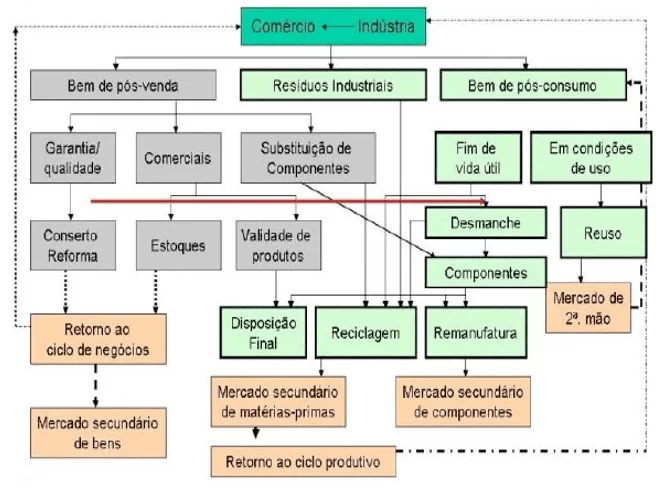
In Figure 2, adapted from milk (2009), the same abbreviated way, but brings no claim to want to exhaust the intricacies of reverse logistics, acting through the main reverse flows in the areas of after sales and post-consumer, observing the relations of interdependence between these.
Until here gave to understand a little about the operation of reverse flow channels of the main logistics chains. We would like now to talk about the impact that the reverse logistics can cause to the environment from environmental awareness promoted by severe environmental laws and consumer awareness, which is forcing the companies using more recyclable materials and also taking these to worry about the ecologically correct disposal of their products at the end of their life cycles, aiming at the sustainability of companies which reinforce and strengthen their images, and our planet that's in the taking of such measures.
3. Environmental awareness and reverse logistics
To Mentzer et. Al (2001) what we call progress is modifying fully the negative environment, i.e. are destroying our planet and its inhabitants of irreversible way, if you do not agree to this scenario. Among many other concepts, sustainable development supports the idea to meet the needs of the present without compromising future generations in meeting their own needs.
To achieve sustainable development it is necessary to have the awareness that our natural resources are not infinite, but they can run out, as is for example the case of oil. Therefore, you have to combine planning with environmental awareness to our planet and future generations stay in prejudice. Sustainable development consistent with a new form of economic development bringing the idea of balance of the various ecological aspects that surround us.
Reverse distribution channels are affected directly by some aspects as, for example, large quantities of urban waste that promote harmful effects on people and their habitats, a very low percentage of recycling of disposable packaging and products that can be recycled or reused. As milk (2002), one of the indicators of the growth of this "disposability" is the increase of urban waste in several parts of the world. The increasing disposability and obsolescence of products observed in the past decade have been reflected in strategic business changes, within the own organization and especially in all links of your network. These changes reflected by "increase speed of response" in its operations since the conception of the project until your product placed on the market, by the adoption of high operating systems "operational flexibility" to allow, in addition to the speed logistics flow, the ability of constant adaptation to the requirements of the client and by the adoption of "environmental responsibility" in relation to their products after they are sold and consumed, which is usually identified as "EPR" (Extend Product Responsibility ) the so-called "Responsibility to the product extension.
Figure 3 structure reinforces the idea of how the increasing disposability of products tends to become more expressive performance of reverse logistics, both in the after-sales sector as in the graduate. Technology, Marketing, logistics and other business areas, through reduction of the life cycle of products, generate increased operational speed needs on one side and cause accelerated exhaustion of traditional means of destinations of post products consumption.
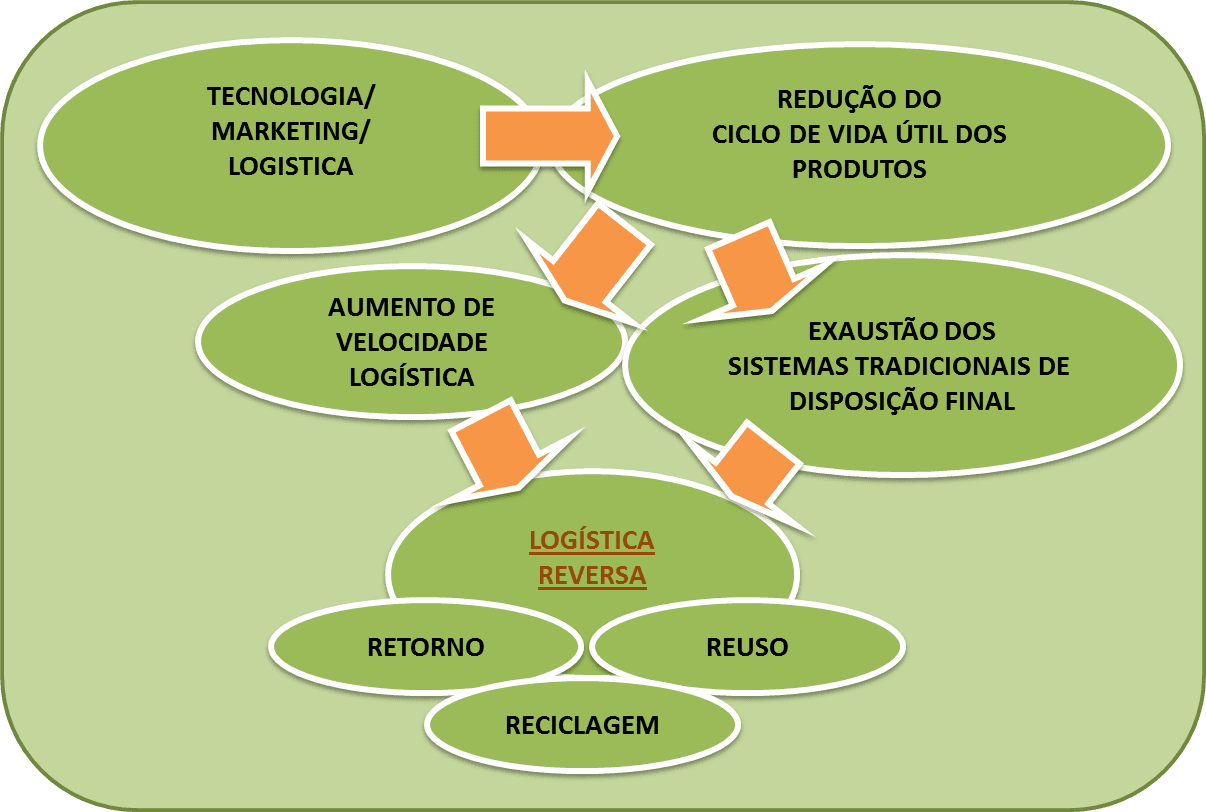
Meanwhile, environmental legislation has exerted strong pressure cool when she blames society for environmental impacts caused by solid wastes, thus promoting, improvements in the global environment, and consumer protection practices sustainable, with the purpose of diminishing through such actions, the negative impacts caused by the improper disposal of waste by society. Because the products must not only engage with the logistics of just deliver the final product to the consumer, but also to give a final destination for this product (reverse logistics), after your consumption, for example, by recycling, to avoid the aggression that those same waste to promote the environment. In this way, by means of recycling for the reuse of materials as feedstock for the development of a new product. Many materials are liable to reuse by companies, such as the recycling of paper, glass, metal and plastic.
The results are quite expressive recycling both within ecological, as social and economic. As regards the ecological aspect, we know that non-renewable raw materials are running out quickly and that is there a illness places to dump solid waste. As regards the economic factor, recycling contributes to more rational and planned usage of natural resources and the restoration of those resources that are capable of reclaiming generating profit for companies. And in the social aspect the whole society benefits from practices that protect the sustainable development.
According to Prestes, et. Al (2010): to achieve the commitment of people with improved environmental quality is important, they understand as an integral part of this process, having access to basic knowledge on environment that help in identifying the main sources causing environmental impacts.
That is why it is necessary to emphasize that the reverse logistics has as its focus the reduction of environment pollution and the waste of raw materials, as well as recycling and reuse of products. In the figure below we have quite the product cycle in the teaching process of reverse logistics.
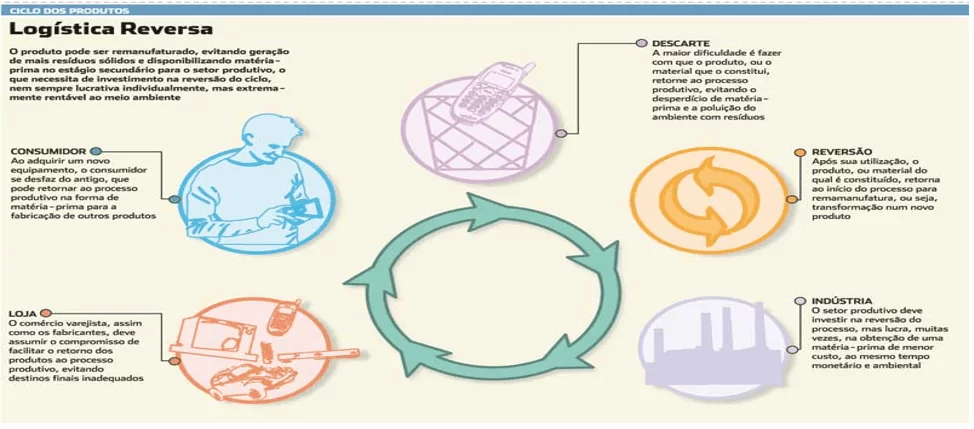
4. Organizational and economic sustainability through reverse logistics
The implementation of the reverse logistics process, in addition to match the requirements of the ISO 14000, may also lead to a reduction of cost in the finished product, especially when there is the reuse of recycled material, although for the deployment of such a system, the fee is a bit high, but the return for organizations that adhere to the reverse system, according to the proponents, are expressive. An example is the economy with the returnable packaging or with the reuse of materials that have brought gains for companies.
To highlight the statement above, take the case of recycling of paper and your impact on your costs. In the manufacture of one tonne of paper, using the paper used both consumption of water, how much energy they fall to about half. Are saved 2.5 barrels of oil, 98000 liters of water and 2500 Kw/h of electricity with a ton of recycled paper. Thus, it is possible the economy of the following natural resources: * wood – a ton of chips can replace 2 to 4 m3 of wood depending on the type of paper to be manufactured, which translates to a new life for 15 to 30 trees; * Water – in the manufacture of one tonne of recycled paper are required just 2000 liters of water, while, in the traditional way, this volume may reach 100,000 liters per tonne. It is envisioned a high economy for example of companies that recycle used paper.
In the figure below we have the example of the paper recycling process used:
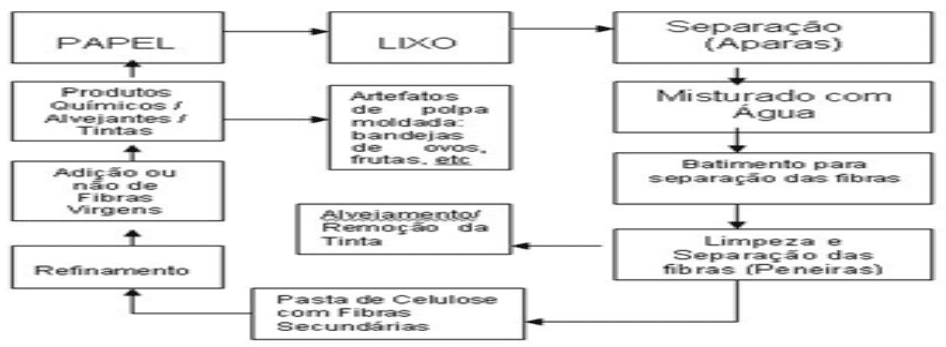
In addition to the above example, in the case of recycling of paper, we can see in milk (2003, p. 128) with regard to the follow-up to the aluminium processing companies, such as the recycling of this, can greatly reduce the cost of electrical energy expenditure:
"The recycling of aluminum saves 95% of the electric energy used for the production of primary aluminum. This cost is significant when one considers that the electrical energy represents 70% of the cost of manufacturing of aluminium ".
Meanwhile, Rogers still Tibben-Lembke and (1998) presented examples of the importance of reverse logistics, retail companies, where the same obtained 25% of their profits derived from better management of your reverse logistics. While Caldwell (1999) cites Estèe Lauder Companies Inc. company managed an economy of $ $30 million in products that she left to dispose (50% of the previous volume) with the implementation of the reverse logistics. And when this company decided to develop the system at a cost of $ $1.2 million, and obtained the payback of 12 months only with the economy in workmanship which dealt with the returns of products by means of reverse logistics to after-sales. The ABC system has the ability to cover the whole supply chain and reduce the total cost of reverse logistics, that Goldsby and Closs (2000) found in the survey with the supply chain of beers and soft drinks where the members of the jail, outsourced the collection process and return of used packaging for recycling, and with this he obtained a higher annual savings to $ $11 million.
The value added to a product is that perceived value by the client that is willing to pay for it. After fulfilling the function of use of the product, your value in principle if you cease to exist, however, for some products, the concept of residual value, as that value can still be recovered, even after the termination of your function. Both ends of the supply chain are favored in this new scenario, on the other hand, the consumer to enter or facilitate the insertion of discarded materials in the reverse flow satisfies your ecological awareness and enables the recovery of part of the amount paid for the product, while the manufacturer will be who will have the greatest benefits, since it will produce new products with significant reduction of costs and inputs. And also via entire supply chain benefits from this reverse flow, since your
institutionalized operation enables new business opportunities and insertion in the labour market a marginalized portion of society.
These are some examples of gains with implementation of reverse logistics in organizations. However, the deployment of the L.R. brings only economic gains but also organizational sustainability by your time, ends that would result in economic gains, because the company that deploys the reverse logistics WINS and goes on to work with the image of an ecologically correct company. That becomes part of the marketing strategy of the enterprise in order to acquire greater respect of consumers beyond the value of their products. SEC (2003), companies are interested in positioning your corporate image as committed to environmental issues and actions properly addressed to environmental preservation, will certainly be rewarded with healthy image returns distinguished as a competitive advantage.
When you adopt a position economically correct, financial and logistical gains are just one of the benefits that the reverse logistics is able to provide. "In this approach, the best solution on the disposal of waste is one in which the binomial environment and profit are combined in such a way that both the environmental guidelines as the financial results are satisfactory, consolidating this vision with the Recycle vision "(SOUZA; FONSECA, 2008, p. 2). You can also add the winnings to the institutional image of the company by attracting clients preference (NETTO, 2004).
5. Costs involved in reverse logistics
The costs involved in reverse logistics vary from business to business, business to practice in a particular organization. Therefore, there is no pattern that serve as a reference for all other companies, with regard to question spending on the implementation of the reverse logistics process. According to some authors the expenses can be high for the implementation of the reverse logistics, however, the returns can be very generous according to the same authors.
In fact, in reverse logistics, companies are responsible for the return of the product to the company for recycling or for disposal. Its costing system should, therefore, have a fairly wide approach, such as the Total life cycle Costing. For Atkinson et al. (2000, 676), this system allows managers to manage costs "from the cradle to the grave". "The life cycle of the product covers the time from the beginning of the P&D until the end customer support". (Horngreen et al: 2000, p. 313). In reverse logistics, this cycle extends, covering also the return of the product to the point of origin. Horngreen et al. (2000, 315) points three benefits provided for preparing a good report of product life cycle: the presentation of the entire revenue and expenses associated with each product, the percentage of the total costs incurred in the early stages and allows the relationship between the categories of cost of activity stand out. The use of a costing system for total life cycle does not traditional systems, such as Meta, Kaizen Costing Costing, activity-based costing (ABC) or process costing. What it provides is the visibility of costs throughout the product life cycle. The total life-cycle costing encompasses the other, depending on the phase of the product, as shown in Figure 6:
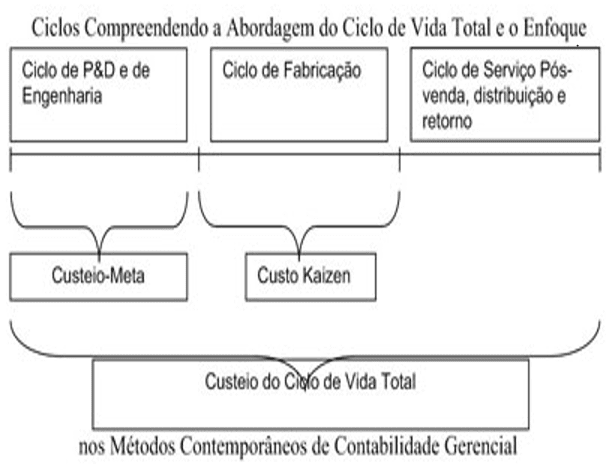
As we can see by the figure 6 above, in each phase can be used a type of costing and Total life cycle Costing is the encompassing all of them. What to keep in mind is the whole cycle from initial P&D for which the product can generate revenue for your life cycle allowing the reimbursement of costs. With the inclusion of the return of the product, we have another factor to be considered. The importance of knowing the point at which the product in your life cycle and the difference in costs incurred in each phase is highlighted in a simple chart that shows the cost of shipment of stocks at each stage of the life cycle of a product. (Rogers and Tibben-Lembke: 1999). As the figure above shows us, in the initial phase the storage costs are relatively low, tending to grow enough as the product progresses in your life cycle. Non-consideration of all phases leads to incorrect lifting of total costs. Tibben-Lembke (2000) and De Brito et al (2002), when talking about the life cycle of the product and the reverse logistics, report the importance of, still in phase of development, be considered as will the disposal or reuse of pieces and parts to end of product life. Automotive companies alongside high-tech companies like IBM and Xerox are cited as examples of companies who design their products already thinking in the last step.
Conclusion
Before all the above this work sought to show so succinct reverse logistics development and the concept given by some authors that reflect on the subject, emphasizing also the strategic competitive position that companies can achieve with the practice of reverse flows. We can, for example, understand how the reverse logistics is relevant to the organizational and environmental sustainability, in the sense that the reverse flow makes gains for businesses, the fortification of organizational brand before your stackholders, as a company correctly. Emphasizing also that industries gain economically with the reuse of secondary raw materials, after sales and post consumption generated without fail to mention the environment that just keeping your sustainability, waste generated by the industries are, or reused by the process of recycling, or are forwarded to receive your order the useful non-aggressive nature. The present and future generations thank also for the responsible use of our natural resources in a manner planned, thus causing a sort of slowing environmental degradation.
Below, in table 1 1 Milk-based framework (2003), here adapted, which summarises all the above so far:
Table 1 – environmental and Economic Benefits with the implementation of the reverse logistics
| ENVIRONMENTAL |
· Mitigate environmental impact of waste and · Save natural resources. Benefits: · Reducing the volume of disposal as much secure as illegal; · Anticipating the requirements of legal regulations; · Energy saving in manufacturing new products; · Reduction of pollution by waste containment spells.; · Restriction of risks from landfills; · Improvement of corporate image and · Ecological awareness. |
| ECONOMICAL |
· Formalize existing businesses; · Increase turnover; · Reduce costs by substituting primary raw materials for secondary matters; · Direct refused to secondary markets and products · Save energy and costs of disposing of waste.
· Creation of new businesses in the production chain; · Reduction of investment in factories; · Savings in the cost of energy in manufacturing; · Increase of cash flow through the marketing of by-products and waste; · Use of distribution channel to drain the secondary secondary markets and products · Improvement of corporate image to get subsidized financing for operating with environmentally friendly practices. |
Source: Milk-based author (2003)
Therefore, it is of the utmost importance that there should be more research and productions that focus on the subject of reverse logistics, given that the fastest growing world population, also grows the demand for consumer goods, which in your time, will be responsible for waste generation in need, through research and development, receiving the correct destination. The reverse logistics reveals itself as a viable solution so that businesses can spend to operate in a sustainable way, and of great importance for the sustainability of our planet.
References
DAHER, c. e. et. Al. Reverse logistics: Opportunity for cost reduction through integrated Value chain management. Available at: http://www.resol.com.br/textos/123016269005.pdf. Access in: 22 August 2017.
Milk, p. r. reverse logistics: new area of business logistics. Available at: <http: meusite.mackenzie.br/leitepr/log%cdstica%20reversa%20-%20nova%20%c1rea%20da%20log%cdstica%20empresarial.pdf="">accessed: 22 August 2017.</http:>
NETTO, r. m. reverse logistics: a new relationship tool. 2004. Available in: <http: www.guialog.com.br/artigos-log.htm="">.</http:> Access in: 10 jul. 2017.
SHIBAO, f. et. Al. Reverse logistics and business sustainability. Available in:<http: web-resol.org/textos/a_logistica_reversa_e_a_sustentabilidade_empresarial.pdf=""></http:>
Access in: 28 Oct. 2017.
Sueli Ferreira de Souza. et. Al. Reverse logistics: opportunities to reduce costs as a result of the evolution of ecological factor. Available at: <http: revistas.ung.br/index.php/3setor/article/view/512/606="">accessed: 09 August.</http:> 2017.
SILVA, Manhas C. G. et. Al. Reverse logistics: tendency of companies focused on sustainability. Available at: http://www2.unifap.br/glauberpereira/files/2016/07/
Log% C3% ADstica-Reversa-e-Sustentabilidade.pdf. Access in: 01 August 2017.
SHARMA, S. F.; FONSECA, S. U. L. Reverse Logistics: opportunities to reduce costs as a result of the evolution of ecological factor. In: seminar in BUSINESS ADMINISTRATION, 11; 2008 in São Paulo, FEA USP. Available at: < http://www.ead.fea.usp.br/semead/11semead/resultado/an_resumo.asp?cod_trabalho="87"> accessed: 06 jul. 2017.
ATKINSON, A. A.; BANKER, R. D.; KAPLAN, R. S.; YOUNG, S. M. Managerial Accounting. São Paulo: Atlas, 2000.
BOWERSOX, D.J.; CLOSS, D.J. Business Logistics: the process of integration of the supply chain. São Paulo: Atlas, 2001.
DORNIER, P-P et al. Global operations and logistics: text and cases. São Paulo: Atlas, 2000.
FULLER, D.A.; ALLEN, J. Reverse Channel Systems. In. Polonsky, M.J.; MINTUWIMSATT, A.T. Environmental marketing: strategies, practice, theory and research. London: The Haworth Press 1995.
HORNGREEN, C T, FOSTER, G and dating, S M, 2000, cost accounting, 9th Ed. Rio de Janeiro: LTC Editora
Milk, p. r. reverse logistics: environment and competitiveness. São Paulo: Prentice Hall, 2003.
Milk, P.R. reverse logistics: environment and competitiveness. São Paulo: Prentice Hall, 2009.
LAMBERT, D. M.; STOCK, J. R.; VANTINE, j. g. strategic management of logistics. São Paulo: Vantine consulting, 1998.
MENTZER, J.T.; DEWITT, W.; KIBLER, J.S.; MIN, s. Defining supply chain management. In Journal of Business Logistics, vol. 22, no. 2, 2001.
ROGERS, D. S.; TIBBEN-LEMBKE, r. Going Backwards: Reverse Logistics Trends and Practices. Reno: Reverse Logistics Executive Council, 1998.
ROGERS, d. s. TIBBEN-LEMBKE,, R.S. Going backwards: reverse logistics trends and practices. Reverse Logistics Executive Council (RLEC), Pittsburgh, 1999.
[1] Bachelor of business administration and professor of professional education: management and entrepreneurship by the State of Bahia














